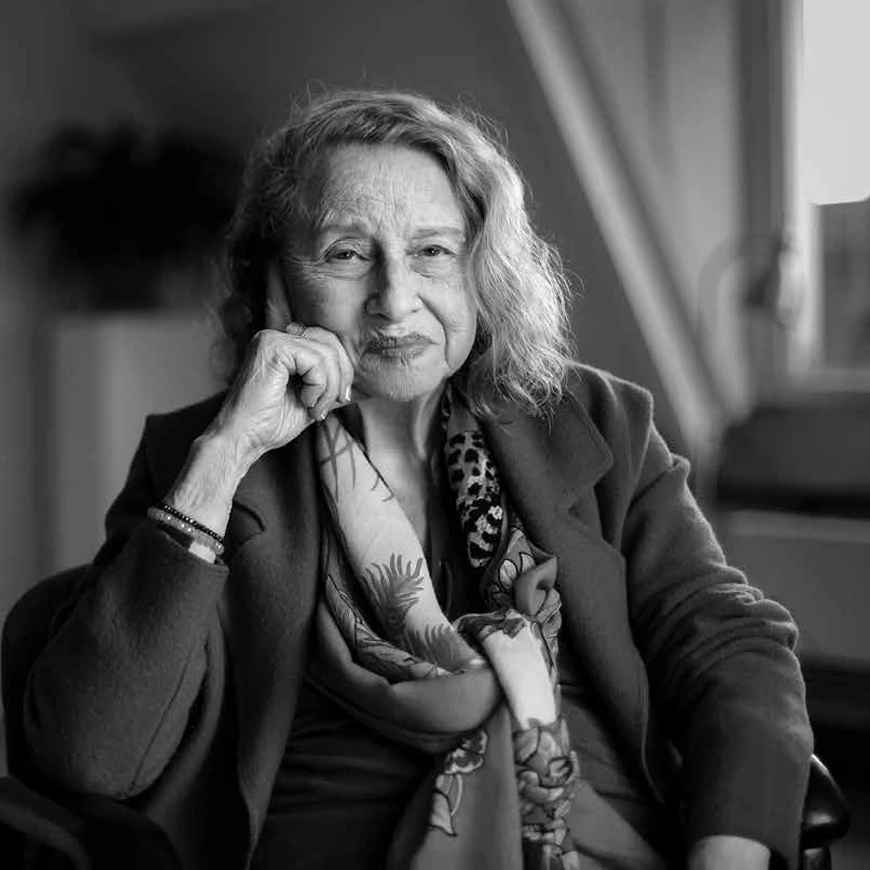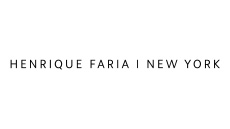Anna Bella Geiger
Brazilian, b. 1933, Rio de Janeiro-based

was among the first Brazilian artists to experiment with video as Art.
Her first artworks, pure abstractions in painting and engraving, launched her career in the early 1950s. Her studies and encounters with artists in New York City during an extensive stay 1953-54 and often thereafter, widened her interest in progressive options for art topics and artmaking. Beyond her celebrated abstract achievements, she is also noted for multimedia works that contemplate Brazilian identity – national, historical, geographical, social, political and personal.
In response to socio-political conditions, precipitated by a coup and the establishment of military dictatorship (1964-1985), Geiger’s approach shifted in the 1960s – first, toward visceral figuration, and then, temporarily away from painting altogether.
In the early 1970s Geiger explored various media to examine how national identity is appropriated and re-constructed as propaganda for political and economic agendas. Geiger analyzed how various versions of past and present reflect indigenous and immigrant communities and how beliefs and policies impact the future of a land that is vast, eco-dynamic, fragile and sacred. This topic continues to be a throughline shared by many Brazilian artists and Geiger’s legion of students.
In 1974 filmmaker Jom Tob Azulay introduced her to video making. The medium provided a new means to analyze the interface between history and memory. Collage, photography, metal and wax sculpture, super 8 film, found-object and text-based works assemblage and artists books as well as installations and performance (she terms Actions), were among the means she cultivated for her artistic arsenal. While covertly resisting the regime, she not only oversaw raising her four children but also emerged as a prolific and influential artist, activist and professor of art.
Her black and white videos from the mid 1970s are as inventive as any that emerged during this period throughout the art world. Her best known early video is Passagens I, 1974 (restored & remastered by BFVPP). For the duration, just under ten minutes, viewers follow Geiger, footstep by footstep, as she climbs three staircases in and near her neighborhood. A close camera observes as she ascends, plodding on, as if lost or perhaps entrapped, in some enigmatic routine. She seems to be pacing out, marking or counting time, but her climbing leads to nothing. In Brazil many art critics were skeptical about whether video could resonate as Fine Art. The international debut of her works in Videoarte Brasil 1975, revealed her patient poetry to be as universal as it is timeless.
By the 1980s the artist re-embraced painting but also perpetuated her multi-media endeavors.
Geiger’s appointments to museum and academic teaching positions continued to expand, notably at the Escola de Artes Visuais do Parque Lage and Columbia University. Her works collected and presented worldwide and included in the XXXIX Venice Biennale, 1980. She was awarded a John Simon Guggenheim Fellowship in 1983 for film research. Also among her many distinctions, Geiger co-authored with Fernando Cocchiarale, a landmark study, Abstracionismo geometrico e informal: A vanguarda brasileira nos anos cinquenta (Temas e debates), 1987. This collection of essays and interviews produced in 1987 and reprinted in 2004 remains an influential resource.
In the 21st century, Geiger’s older and current artworks continue to make waves. Her achievements have been showcased in notable exhibitions such as Radical Women: Latin American Art, 1960-1985 and a major retrospective, Anna Bella Geiger: Native Brazil/Alien Brazil (the Netherlands, Belgium, Brazil). Among her ongoing projects is Circa, 2006-2019, a multi-media installation that morphs in each iteration. Initial editions featured a model of a crumbling pyramid within the ruins of a sandy excavation site. Adjacent projection, added ruminations about the manipulation of dates and narratives that emerge from archeological discoveries. To date, the artist has adapted the work for each host venue incorporating locally-sourced sand and adjusting emphasis to illuminate how these notions mirror issues in local histories and current global situations. Circa, reflects her ingenuity for engaging meanings, materials, timeliness, timelessness and contemporaneous zeitgeist. Ever-provocative, Geiger questions how past monuments and artifacts are deployed to “attest” to conquest, culture and collective identity and how this circumstance informs history and memory.
Countless Brazilian and international exhibitions affirm the continuing relevance of Geiger’s themes and experimentation. She has remained as devoted to her studio endeavors as she is to presenting courses, lectures, interviews and commentaries. Her impact is ever-expanding among those who study her and, those who have, or currently, study with this tireless pioneer.



Filmography
-
Circumambulatio (1972)
-
Telefone sem fio (1976)
-
Ideologia (1982)
-
Pedra — objeto de arte (1982)
-
Burocracia (1982)
-
Sobre a Arte (1983)
-
O sorriso do gato Cheshire em Alice (no País das Maravilhas) (1994)
-
Rrose Sélavy (1997–2011)
-
Eject (2001)
-
Out of control (2002)
-
Estou no mato, estou no mar… (2003)
-
Circa I, II e III, videoinstalação (2006, 2007, 2008)
-
Circa IV, Circa V (2009)
-
Zona Portuária com águas dos mares (2010)
-
Circa V (2011)
-
Cuidado, cão feroz (2012)
-
Trenzinho (2012)
-
Passagens III (2016)

BFVPP Essays
Marisa Flórido César, 2020
Anna Bella Geiger once defined her artistic process “as a cross-border flux, assorted choreographies moving from one territory to another”[1]. But in this flux, countless territories emerge and clash with the various borders that control them
Pablo Larios, 2020
Writing about one of her installations – an archaeological topography she titled Circa (2006) – Anna Bella Geiger noted a contradiction that is central to the scientific demarcation of time, place and history.
Conversation
Anna Bella Geiger by Vivian Ostrovsky
with Ruti Gadish, 2019.
Ostrovsky is an experimental filmmaker, noted for her on-going series of portraits of progressive women artists, filmmakers, writers and choreographers. Gadish a frequent collaborator, is a filmmaker and film editor.
Synopsis
Footage from a series of BFVPP studio interviews is at the center of this experimental biography.
Resources
For Anna Bella Geiger’s biographical details, consult:
For overview of Anna Bella Geiger’s studies and teaching, visit :
For overview of Anna Bella Geiger’s studies and teaching, visit :

Anna Bella Geiger : Native Brazil/Alien Brazil
Exhibition catalog for touring retrospective, 2021-2023. Curator, Tomas Toledo. Publishers – Museu de Arte de São Paulo Assis Chateaubriand (MASP), Municipal Museum of Contemporary Art, Ghent (SMAK).

Encounters in Video Art in Latin America
Editors, Elena Shtromberg, Glenn Phillips
Volume of essays by various authors. Publisher – Getty Publications, 2023

Hans Ulrich Obrist: entrevistas brasileiras. Vol. I
Interviews with artists and intellectuals born before 1959, consider the impact of Brasilia and the emergence of Brazilan modernism. Publisher – Cobogo Editoria, 2019

Radical Women: Latin American Art 1960-1985
Curators, Cecilia Fajardo-Hill, Andrea Giunta
Exhibition catalog for touring exhibition, 2017 Publisher – Hammer Museum

Anna Bella Geiger Physical and Human Geography
Curator, Estrella de Diego
Exhibition catalog for touring exhibition, 2017 Publisher – La Casa Encendida.

Filmes de Artista Brasil 1965-80
Curator, Fernando Cocchiarale
Exhibition catalog, Oi Futuro, 2008 Publisher – Contra Capa

Inverted Utopias: Avant-Garde Art in Latin America
Curators Mari Carmen Ramirez, Hector Olea
Exhibition catalog, Houston Museum of Fine Arts, 2004 Publisher – Yale University Press
INTERNATIONAL INSTITUTIONAL COLLECTIONS
Geiger’s works in all media have become part of major institutional collections including Centre Pompidou, Museum of Modern Art , the Getty Museum , the Victoria and Albert Museum and Reina Sofia.







